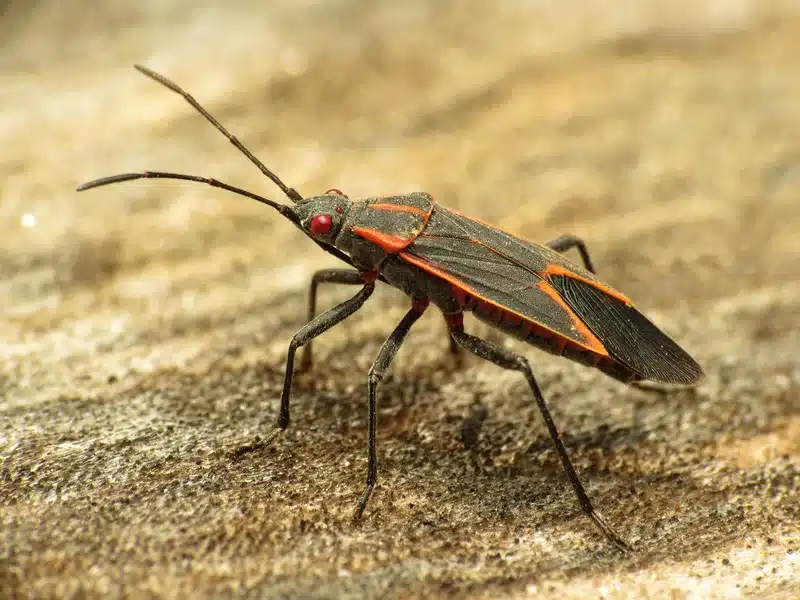Boxelder bugs are one of the most common overwintering pests we encounter in the DMV area. As a registered technician with four years of experience in our family business, I’ve seen countless homeowners dealing with these red and black insects swarming their properties each fall.
Understanding what do boxelder bugs eat is crucial for effective control. These insects have very specific dietary preferences that directly influence where they show up and how to manage them. In my experience serving the DMV region for over 50 years as a family business, knowing their feeding habits makes all the difference in developing an effective treatment plan.
Boxelder Bug vs Stink Bugs: Biology, Identification & Do They Bite Humans?
Boxelder bugs belong to the order Hemiptera and family Rhopalidae. They’re true bugs, not beetles, which explains their piercing-sucking mouthparts. Adults measure about half an inch long with flattened, charcoal-black bodies featuring three distinctive red or orange stripes on their backs.
The nymphs look quite different from adults. They start out bright red with black wing pads and legs. As they develop through five growth stages, their coloring gradually darkens. Eggs begin straw-yellow but turn red as the young bugs develop inside.
Many homeowners confuse boxelder bugs with other similar insects. Milkweed bugs have a large white X pattern on their backs instead of three stripes. Red-shouldered bugs only have two red stripes rather than three. Getting the identification right matters because it determines what food sources to target. For detailed identification help, check out our red and black beetle identification guide.
What Do Boxelder Bugs Eat: Primary Food Sources
Female boxelder trees provide the main food source for these insects. Specifically, boxelder bugs feed on the developing seeds (called samaras) and fallen seeds from female boxelder trees (Acer negundo). They use their needle-like mouthparts to pierce the seed pods and suck out the nutritious fluids inside.
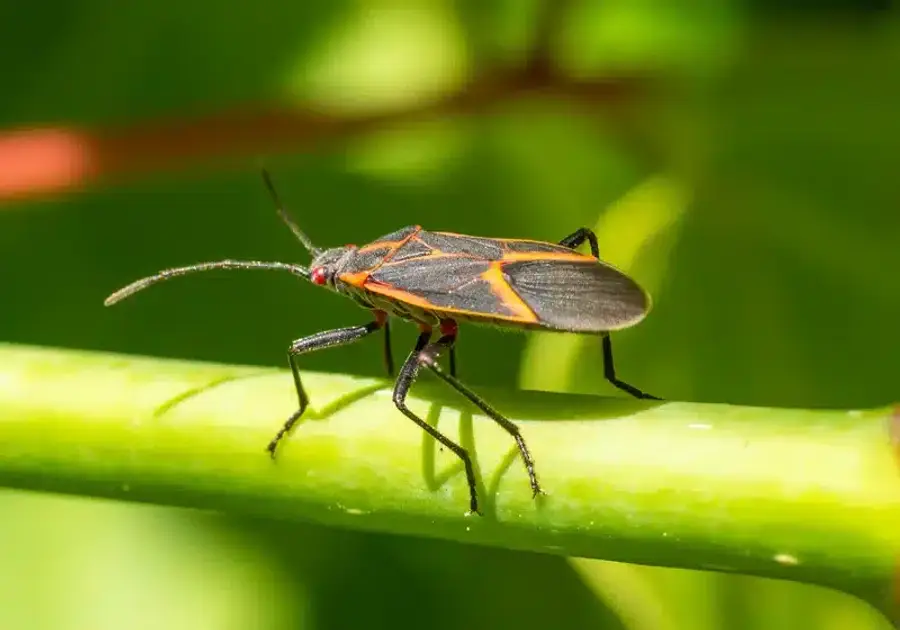
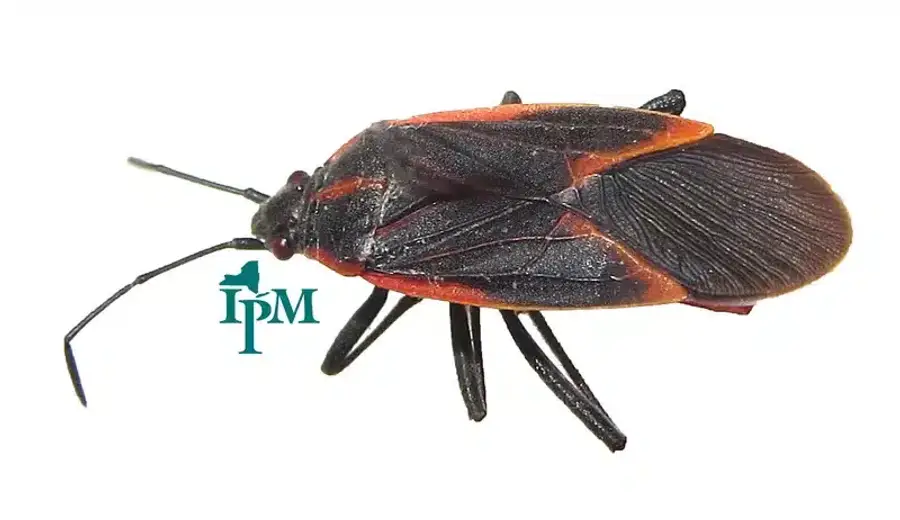

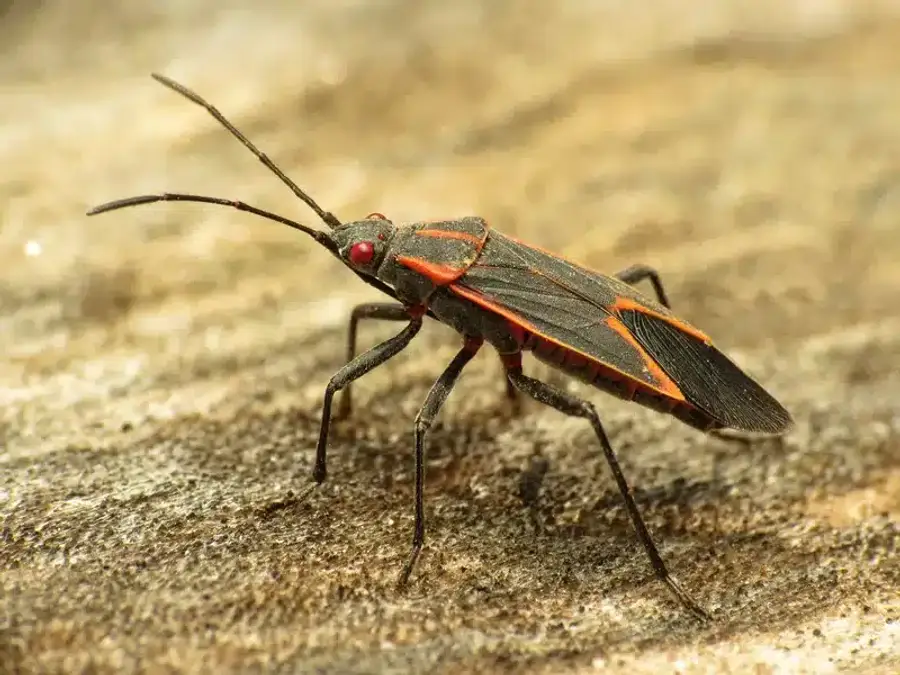
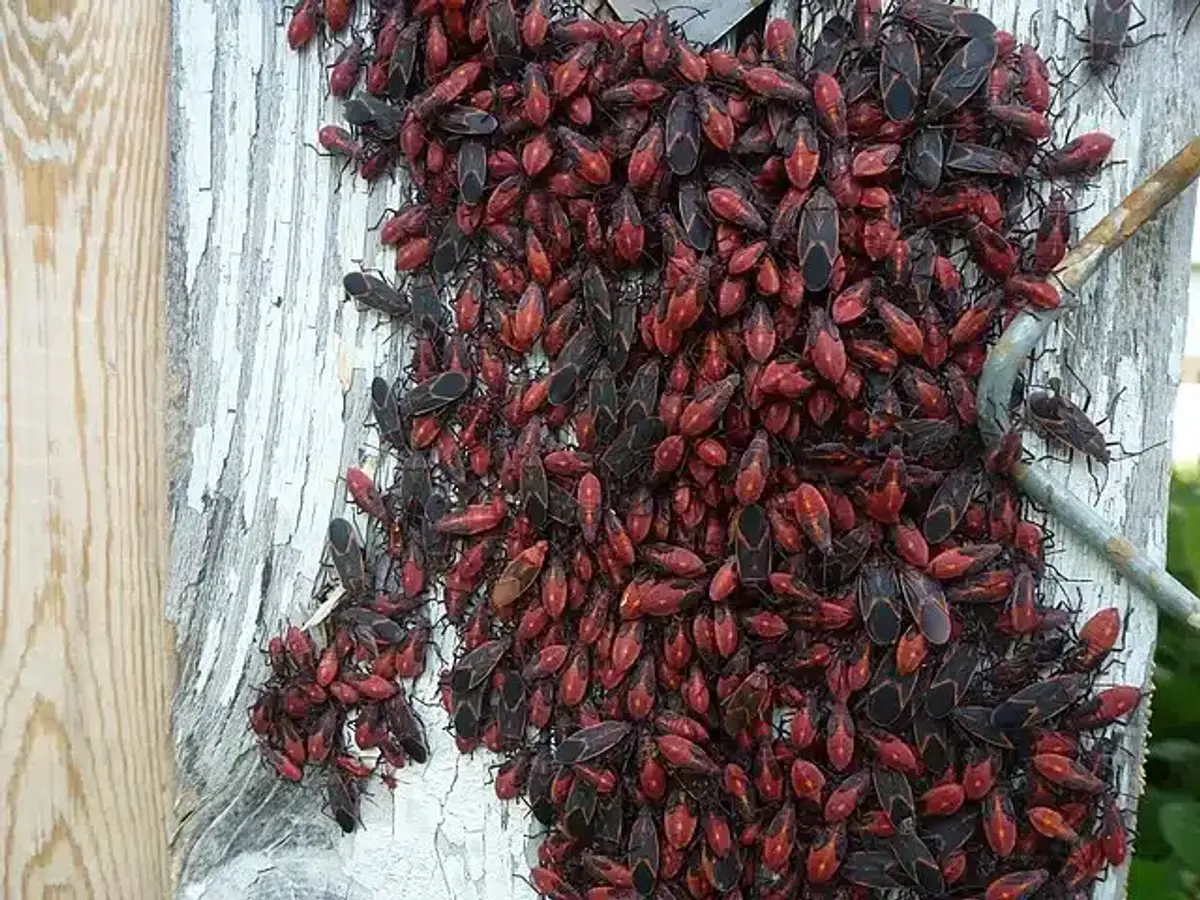
The timing of this feeding is important. Adults emerge from overwintering sites in late April to early May as the boxelder buds start expanding. They immediately begin feeding on the developing seeds. This spring feeding gives them energy to mate and lay eggs.
Most of the feeding damage occurs during late spring through early summer. The bugs concentrate their feeding efforts when the seeds are developing and contain the most nutrients. This is why you’ll often see large clusters of red nymphs around the base of female boxelder trees during June and July.
What Do Boxelder Bugs Eat: Secondary Hosts & Occasional Foods
While female boxelder trees remain their preferred food, these bugs also feed on other maple family trees. Silver maples and red maples serve as secondary hosts, especially in mixed urban landscapes common throughout Virginia, Maryland, and DC.
Additionally, boxelder bugs occasionally feed on:
- Ash trees
- Buckeye trees
- Apple trees
- Plum trees
- Grape vines
- Stone fruit trees
When they feed on fruit trees, the damage is mostly cosmetic. You might notice some surface distortion on fruit, but this rarely affects the overall health of the tree. The feeding is usually limited to surface tissues rather than deep penetration.
According to the University of Maryland Extension, the real concern for homeowners isn’t tree damage but rather the indoor invasion that follows outdoor feeding.
How Boxelder Bugs Feed: Behavior & Seasonal Diet Shifts
Boxelder bugs show interesting feeding patterns throughout the year. Overwintering adults don’t feed at all during their dormant period from October through April. They survive off stored body fat accumulated during the previous growing season.
Once spring arrives, feeding becomes their top priority. The adults need nutrition to reproduce and lay eggs. After mating, females deposit eggs in bark crevices of their host trees. The resulting nymphs go through five feeding stages over 10-14 days.
The bugs are strongly social creatures. You’ll rarely find them feeding alone. Instead, they form large aggregations for thermoregulation and protection. These feeding clusters can be quite impressive, sometimes covering entire tree trunks.
Life Cycle & Seasonal Phenology in the Mid-Atlantic
Understanding when boxelder bugs feed helps predict when they’ll become a problem. In our DMV climate, the cycle follows a predictable pattern that I’ve observed consistently over my years in the field.
Spring emergence happens in late April to early May as temperatures warm. Adults exit their overwintering sites and immediately begin feeding on expanding buds and developing seeds. Egg laying follows quickly after temperatures stabilize.
The region typically sees one to two generations per year depending on heat accumulation. Second-generation adults mature in August and September. These are the bugs that create the massive fall congregations homeowners notice on south and west-facing walls.
Fall aggregation starts in October as bugs prepare for winter. This is when they’re most likely to find their way into homes. Warm winter days above 50°F can trigger false spring emergence, leading to indoor appearances that surprise homeowners. For more detailed information about their development, see our boxelder bug life cycle guide.
What Boxelder Bugs Cause: Signs of Infestation & Damage
The feeding signs are typically cosmetic rather than harmful. You might notice small puncture marks on seed pods or slight discoloration where bugs have been feeding. Some seeds may appear shriveled or distorted.
Indoor signs are more concerning for most homeowners. Large numbers of bugs congregating on sunny exterior walls indicate they’re preparing to enter your home. Once inside, they don’t feed or reproduce but instead become a nuisance through their smell and potential staining when crushed.
The bugs release a strong, unpleasant odor when disturbed. This malodorous smell comes from aldehydes and ketones they produce for defense. While harmless to humans, the odor can be quite persistent in indoor spaces.
Why Boxelder Bugs Invade Homes: Fall and Winter Nuisance
After completing their feeding and reproduction cycle outdoors, boxelder bugs seek protected overwintering sites. Their goal isn’t to continue feeding indoors but rather to find a stable environment to survive winter temperatures.
South and west-facing walls warm up in the sun, attracting massive congregations. From these gathering points, bugs find entry through:
- Gaps behind window and door trim
- Unscreened soffit vents
- Cable and utility penetrations
- Cracks wider than 1/8 inch
Once established in wall voids or attics, they remain dormant until spring or until warm winter weather triggers premature activity. This explains why homeowners sometimes find active bugs indoors during January or February warm spells.
Monitoring & Inspection Points
Based on my experience, effective monitoring focuses on the connection between food sources and entry points. During June and July, inspect the trunk bases of any female boxelder trees for red nymph clusters. This early detection helps predict fall invasion pressure.
Pre-overwintering surveys in September and October are crucial. Look for bug congregations on sun-exposed white siding, foundations, and soffits. These gathering areas indicate where entry attempts will be highest.
Indoor inspection should focus on potential entry points around window seals, door frames, and baseboards. Check attic access points and basement areas where bugs might establish overwintering sites.
How to Get Rid of Boxelder Bugs: Non-Chemical Control Strategies
Prevention works better than treatment for boxelder bugs. Exclusion remains the most effective approach I recommend to homeowners. Seal any cracks or gaps wider than 1/8 inch using silicone caulk or expanding foam. Pay special attention to areas around windows, doors, and utility penetrations.
Habitat modification can provide long-term relief. Consider removing female boxelder trees or replacing them with non-host species. However, remember that these bugs can fly 3-4 kilometers, so nearby trees may still contribute to your problem.
Mechanical removal works well for active infestations. Use a shop vacuum with disposable bags to remove indoor bugs. The vacuum prevents odor release better than crushing them. For outdoor congregations, a hard water spray can wash bugs off siding - they drown easily and won’t return to the same spot.
Chemical Control Options & Best Practices
Chemical treatments are rarely necessary for boxelder bugs according to Penn State Extension. When justified, timing becomes critical. Late summer or early fall perimeter treatments using residual insecticides can reduce indoor invasion pressure.
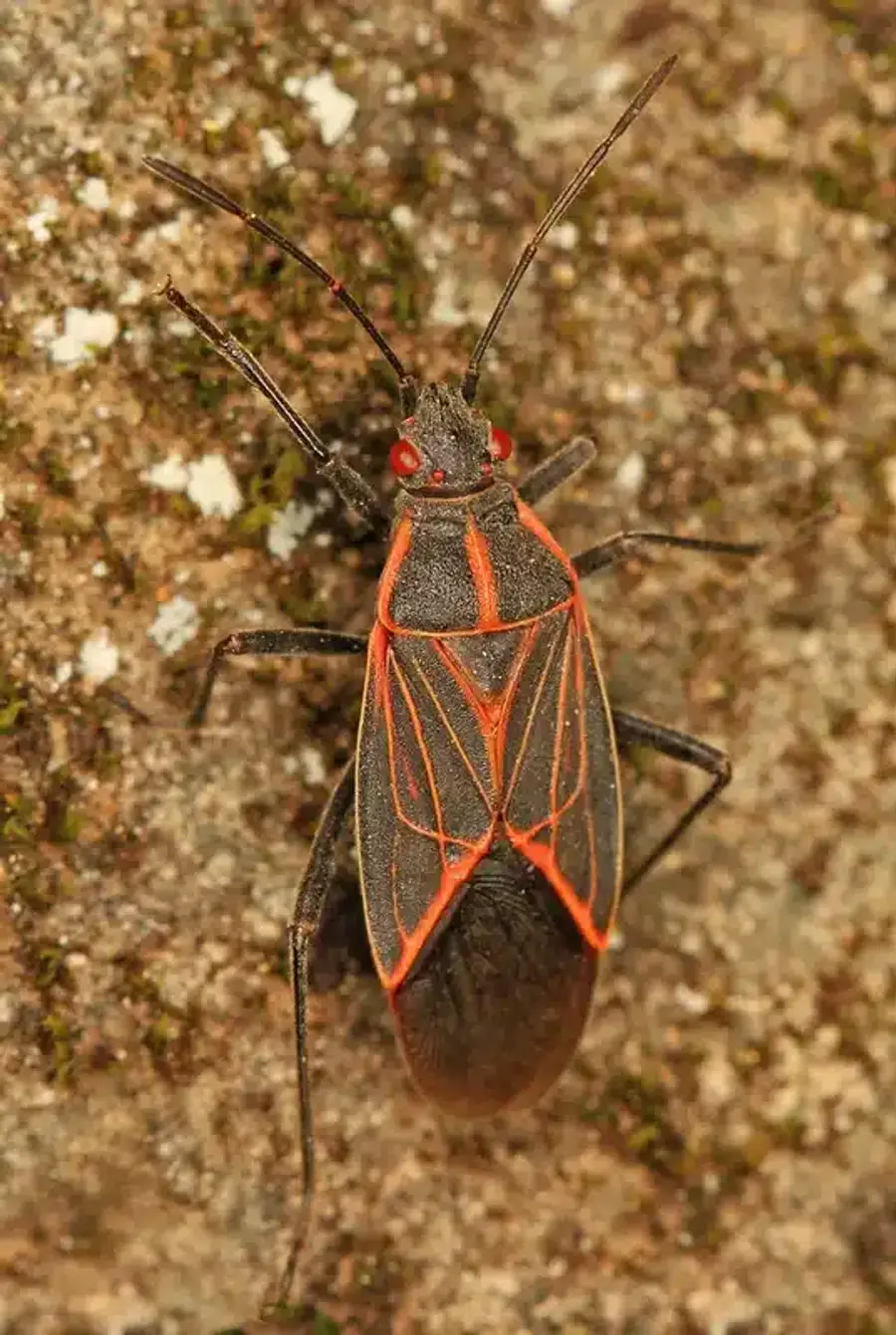



For spot treatments, insecticidal soap mixed with water surfactant effectively controls trunk congregations. Household dish soap solutions also dehydrate nymphs but provide no residual protection. These approaches work well for targeted control without broad environmental impact.
Professional perimeter treatments using products like Bifen IT should be applied by licensed applicators. The treatment targets exterior surfaces where bugs aggregate before entering homes. Interior applications are generally discouraged as they may create other pest issues.
Environmental & Regulatory Considerations for VA/MD/DC
Virginia and Maryland both require proper certification for commercial outdoor insecticide applications. The Virginia Pesticide Control Act and Maryland Department of Agriculture establish strict guidelines for residential treatments.
Our research team has evaluated products specifically for reduced environmental impact. We’ve eliminated 9 chemicals common in the industry, choosing alternatives like Essentria and EcoVia that meet our family’s standards. All products we use are EPA approved and pass through our internal research team review.
Homeowners applying their own treatments must follow label directions carefully. Several Mid-Atlantic states have restrictions on certain neonicotinoids, making label compliance especially important.
Expert Insights from the Field
During my four years as a registered technician, I’ve noticed some common patterns with boxelder bug problems. Homes with substantial female boxelder trees consistently see higher invasion pressure. However, tree removal alone doesn’t guarantee complete relief due to their flight capabilities.
Our family business has been serving the DMV area for over 50 years. In that time, we’ve seen how urban development affects boxelder bug patterns. Ornamental plantings of female boxelder trees in suburban developments often create concentrated problem areas.
The most successful control programs combine exclusion, habitat modification, and targeted treatments. Homeowners who focus solely on chemical control often see recurring problems because they haven’t addressed the underlying attractants.
The Better Method: Our Pest Management Approach for Boxelder Bug Infestation
Our family’s approach starts with an expert phone consultation. Our licensed technicians take your call directly - no phone trees or overseas operators. You’ll get a detailed quote and treatment plan based on your specific situation.
We perform a comprehensive 78-point home inspection to identify both active problems and potential trouble spots. Our initial treatment uses products that have passed through our internal research team. We’ve removed 9 of the harshest chemicals common in our industry.
For ongoing protection, we establish seasonal treatment schedules that target specific pests when they’re most active. Plus, if you spot a problem between visits, we’ll come back at no extra cost. Every year, our safety coordinator completes an annual review to ensure your home meets our strict requirements.
Local Expertise Across the DMV Region
Our understanding of local conditions helps us provide targeted solutions. We serve communities throughout Virginia, Maryland, and DC, adapting our approach to regional pest pressure and environmental factors.
Our King George pest control services address the rural-suburban mix common in that area. Urban environments like Bethesda pest control require different strategies due to dense tree coverage and older construction.
Planned communities present unique challenges. Our Reston termite control experience demonstrates how comprehensive pest management adapts to specific community designs. Similarly, our Accokeek pest control services address the moisture and vegetation factors common to that region.
Comprehensive Boxelder Bug Resources
For homeowners dealing with boxelder bugs, several resources provide additional guidance. Our how to kill box elder bugs guide offers detailed treatment methods. The complete removal guide covers both immediate solutions and long-term prevention.
Understanding whether boxelder bugs are harmful helps put the problem in perspective. While they don’t cause structural damage, their nuisance factor makes control worthwhile for most homeowners.
External resources from the University of California IPM provide research-based guidance on exclusion tactics and tree management decisions.
Conclusion & Next Steps
What do boxelder bugs eat directly influences where and when they become problematic. Their preference for female boxelder tree seeds drives their seasonal behavior and helps predict invasion patterns. Understanding this connection allows for more effective prevention and control strategies.
The most successful approach combines exclusion techniques with habitat modification. While chemical treatments can provide short-term relief, addressing food sources and entry points creates lasting solutions. Focus on sealing entry points before fall congregations begin and consider long-term landscape changes to reduce attractant trees.
If you’re dealing with boxelder bugs or want to prevent future problems, our team can help develop a customized solution. Call us at 703-683-2000 or email info@bettertermite.com for expert guidance on what do boxelder bugs eat and how to keep them out of your home.
Frequently Asked Questions
What attracts boxelder bugs to my property?
+
Female boxelder trees are the primary attractant since they provide the main food source. Additionally, south and west-facing walls that warm up in the sun draw large congregations as bugs prepare for winter. Homes with multiple entry points like unsealed cracks and gaps also experience higher invasion rates.
How can I eliminate boxelder bugs without chemicals?
+
Exclusion works best for long-term control. Seal cracks wider than 1/8 inch around windows, doors, and utility penetrations. Use a shop vacuum to remove indoor bugs and spray outdoor congregations off with a hard water jet. Removing female boxelder trees provides the most significant long-term impact.
Do boxelder bugs damage trees when they feed?
+
The feeding damage is primarily cosmetic rather than harmful to tree health. You might notice puncture marks on seed pods or slight discoloration, but this rarely affects the overall vigor of mature trees. The main concern is the attraction the feeding sites create for fall home invasion.
Will boxelder bugs bite people or pets?
+
Boxelder bugs do not bite humans or pets. They lack the mouthpart structure for biting and pose no health risks. Their primary defense is releasing a malodorous smell when disturbed. The biggest concerns are nuisance issues like staining fabrics when crushed and the unpleasant odor they produce.
When do boxelder bugs typically enter homes?
+
Fall congregations begin in October as temperatures drop and bugs seek overwintering sites. However, warm winter days above 50°F can trigger false spring emergence, causing indoor appearances during January or February. Spring emergence occurs in late April to early May as bugs exit overwintering sites.
Should I remove maple trees to prevent boxelder bugs?
+
Removing female boxelder trees reduces local food sources but doesn't guarantee complete elimination since bugs can fly 3-4 kilometers from other trees. Consider removal if you have heavily infested trees close to your home, but combine this with exclusion techniques for best results.
Are chemical treatments necessary for boxelder bug control?
+
Chemical treatments are rarely necessary according to university extension services. Exclusion and mechanical removal typically provide better long-term results. When chemicals are justified, late summer perimeter treatments by licensed applicators can reduce indoor invasion pressure.
How long do boxelder bugs live and when do they reproduce?
+
Adults can live up to one year, spending 6-8 months in overwintering sites. They reproduce in late spring after emerging from winter dormancy. The DMV region typically sees one to two generations per year, with second-generation adults maturing in August and September before seeking overwintering sites.
Have more questions about what do boxelder bugs eat or need help with an active infestation? Contact Better Termite & Pest Control at 703-683-2000 or email us at info@bettertermite.com for expert assistance from our licensed technicians.
With five years of hands-on experience in the pest control industry, George Schulz is a registered technician with the Virginia Pest Management Association and a proud third-generation professional in a family business that's been protecting homes for over 57 years. He manages and trains a team of service pros while also leading internal research efforts—recently spearheading a deep-dive review of thousands of documents on pest control materials to hand-pick the most kid and pet friendly, most effective solutions tailored specifically for homes in the DC metro area.
